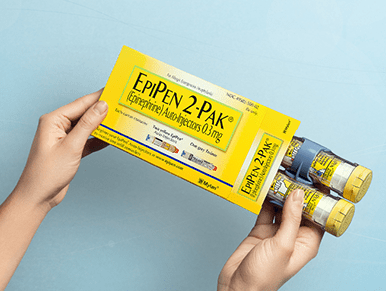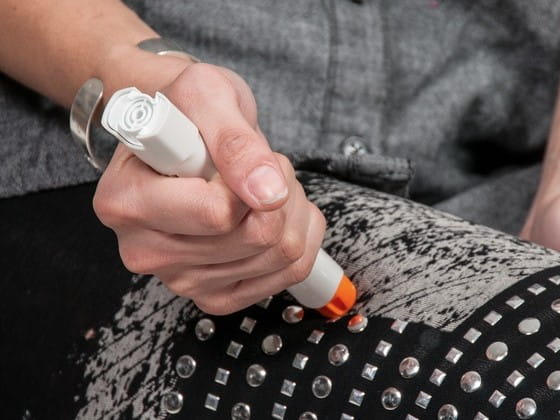Epinephrine Auto-Injectors: Avoiding Accidental Injection

The Bottom Line
Anaphylaxis is a life-threatening allergic reaction. Life-saving epinephrine auto-injectors are used to treat anaphylaxis. Use them safely to prevent accidentally pricking your finger. Unintentional injection of epinephrine into fingers or hands can limit blood flow and cause injury.

What is anaphylaxis?
Anaphylaxis is a life-threatening allergic reaction that can occur within seconds to minutes after someone has been exposed to an allergen. Allergens that can cause anaphylaxis can be as common as insect stings, foods such as nuts or milk, and antibiotics. Most cases of anaphylaxis occur at home, but they may also occur at school, in the workplace, while dining out, and during travel.
Anaphylaxis is caused by the body's immune system releasing histamine and other substances. During an anaphylactic reaction, the airway swells and closes up, the tongue can swell, and blood pressure drops. Other common reactions that are not life-threatening include nausea, vomiting, dizziness, hives, and rash.
How do EpiPens work?
Epinephrine is the first-line treatment for anaphylactic reactions. People who know they are at risk often carry epinephrine in prefilled syringes called epinephrine auto-injectors (EAIs). They can treat themselves as soon as an anaphylactic reaction begins. Epinephrine relaxes the airway muscles, making it easier for the person to breathe. At the same time, it constricts blood vessels, improving blood pressure.
Most EAIs contain enough solution for one doe of epinephrine. EAIs should only be injected into the middle of the outer area of the thigh muscle when a severe allergic reaction begins. Common EAI brand names include EpiPen, Auvi-q, Adrenaclick, and Symjepi. Generic products are also available.
What happens if you use an EpiPen without needing it?
The side effects of an epinephrine injection can include anxiety, tremor, weakness, high blood pressure, heart palpitations, sweating, nausea, and vomiting.
What happens if epinephrine is injected into a finger?
Because injecting an EAI requires use of the hands, accidental injections into fingers occasionally occur during emergencies, causing blood vessels at the site of injection to constrict. Blood vessel constriction decreases blood flow to the area. An EAI injection into a finger can cause several symptoms:
- Skin in the affected area feels cool or cold to touch.
- Skin in the affected area appears dusky, pale, or even bluish in color.
- The finger or hand might feel numb or have a "pins and needles" sensation.
- Capillary refill is delayed.
- This is a quick test to determine if blood flow is diminished to a finger or toe. In this test, the nail bed is briefly pressed down until the nail turns white (blanched). When the nail bed is released, the normal pink color should return within 2 seconds. If delayed, it means that circulation to that area might be affected.
- Pain and bruising at the injection site are common.
What to do if epinephrine is injected into a finger.
If someone injects epinephrine into a finger or hand, immediately soak the affected finger or hand in warm water or wrap it in a warm compress, such as a washcloth or towel dampened with warm water. Message it gently. Then, call Poison Control immediately at 1-800-222-1222. A poison specialist (a pharmacist or registered nurse trained in toxicology) will ask a few questions. Many cases can be managed at home with simple treatment and close monitoring. If it’s been an hour or more since the injection, you can also use the webPOISONCONTROL online tool for help.
If more treatment is needed, Poison Control will recommend care in an emergency room. The ER staff can use other treatments.
Lynn Clark, RN, BSN
Certified Specialist in Poison Information
Rose Ann Gould Soloway, RN, BSN, MSEd, DABAT emerita
Clinical Toxicologist
Revised William G. Troutman, PharmD
Professor of Pharmacy Emeritus
Poison Control Media Information
Did you find this page helpful? If so, we need your support. Poison Control is in constant competition with misinformation online. Links to www.poison.org or our webPOISONCONTROL triage tool from other websites and blogs help internet searchers quickly find accurate information and Poison Control’s contact information in an emergency. If you use the content from this page, please provide attribution via a link back to this page, www.poison.org, or https://triage.webpoisoncontrol.org/#!/exclusions. By doing so, you could save a life. Thank you!
Poisoned?
Call 1-800-222-1222 or
Prevention Tips
- Learn how to use epinephrine auto-injectors. Everyone who might be in the position to administer the medicine needs to know how, including patients, caregivers, parents, teachers, and spouses.
- Keep the medication in its plastic carrying tube, tightly closed and out of reach of children.
- Most devices have a colored safety release over the needle. Keep this release on until you give the medicine.
- Never put your thumb, finger, or hand over the needle area of an epinephrine auto-injector.
This Really Happened
Case 1. A 15-year-old boy found an EpiPen on a bus. He unintentionally injected the epinephrine into the tip of his thumb. In an emergency room, his thumb was cold and pale. The boy complained of pain, numbness, and tingling. His capillary refill time was 5 seconds, indicating that blood vessels in his thumb were constricted and limiting blood flow. He was treated by soaking his thumb in warm water and applying nitroglycerin paste to relax his blood vessels. It took 6 hours for complete blood flow to be restored to his thumb (from Velissariou et al., 2004).
Case 2. A mother called Poison Control because her 4-year-old son found the mother's EpiPen in her travel bag and stuck himself in the thumb. The boy had initial pain at the site with a small amount of bleeding. The thumb was pale, and, after 1 hour, some bruising started to form. The mother soaked the boy’s thumb in warm water and massaged the area. His capillary refill time was less than 3 seconds, not much longer than normal. The mother was advised to continue the warm soak for a short time longer and then allow the boy to go to bed for the night. By the next morning, the boy's thumb was back to its normal color.
For More Information
Epinephrine injection. MedlinePlus. Revised May 15, 2023. Accessed October 19, 2024.
References
EpiPen. Prescribing information. Mylan Specialty L.P. August 2012. Accessed October 19, 2024.
Poisoned?
Call 1-800-222-1222 or
Prevention Tips
- Learn how to use epinephrine auto-injectors. Everyone who might be in the position to administer the medicine needs to know how, including patients, caregivers, parents, teachers, and spouses.
- Keep the medication in its plastic carrying tube, tightly closed and out of reach of children.
- Most devices have a colored safety release over the needle. Keep this release on until you give the medicine.
- Never put your thumb, finger, or hand over the needle area of an epinephrine auto-injector.
This Really Happened
Case 1. A 15-year-old boy found an EpiPen on a bus. He unintentionally injected the epinephrine into the tip of his thumb. In an emergency room, his thumb was cold and pale. The boy complained of pain, numbness, and tingling. His capillary refill time was 5 seconds, indicating that blood vessels in his thumb were constricted and limiting blood flow. He was treated by soaking his thumb in warm water and applying nitroglycerin paste to relax his blood vessels. It took 6 hours for complete blood flow to be restored to his thumb (from Velissariou et al., 2004).
Case 2. A mother called Poison Control because her 4-year-old son found the mother's EpiPen in her travel bag and stuck himself in the thumb. The boy had initial pain at the site with a small amount of bleeding. The thumb was pale, and, after 1 hour, some bruising started to form. The mother soaked the boy’s thumb in warm water and massaged the area. His capillary refill time was less than 3 seconds, not much longer than normal. The mother was advised to continue the warm soak for a short time longer and then allow the boy to go to bed for the night. By the next morning, the boy's thumb was back to its normal color.
